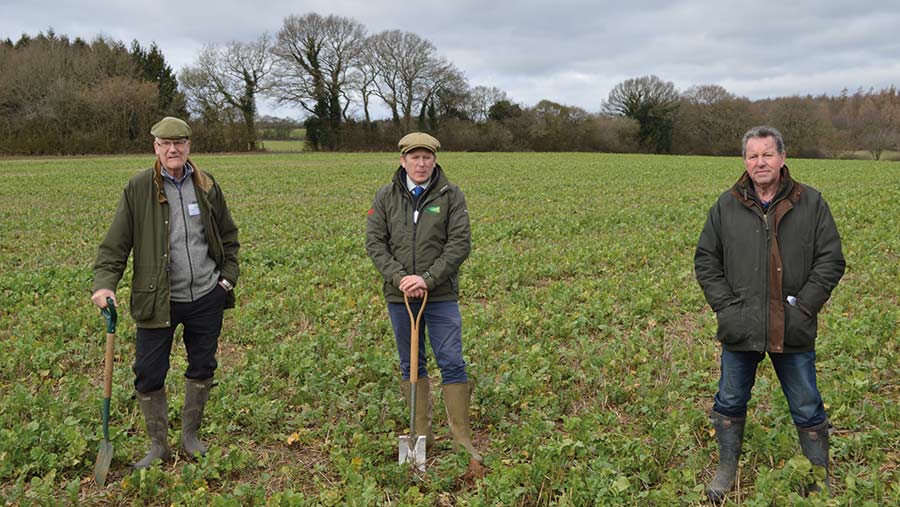Cover crops help cut fertiliser costs for spring barley grower
 Left to right: Tim Clark, Will Moynan and Ian Margetts © MAG/David Jones
Left to right: Tim Clark, Will Moynan and Ian Margetts © MAG/David Jones As fertiliser costs spiral, Hampshire arable grower Ian Margetts is looking to cut nitrogen applications on his spring malting barley by up to 15% this season, as a result of better soil fertility following years of cover cropping.
He started growing cover crops about 12 years ago to absorb any excess nitrogen left over after harvest in his sensitive water catchment area, and also to improve the organic matter of the chalky loamy soils on Malshanger Farm, where he is estate manager.
Some 100ha of cover crops are grown on the 840ha farm, just west of Basingstoke, and Mr Margetts is aiming to cut nitrogen fertiliser on his spring malting barley and still get a good yield of a malting grain sample.
“We are looking to reduce our nitrogen on the spring barley by 10-15% driven by the effect of the cover crops while also looking at the price of nitrogen fertiliser,” he tells Farmers Weekly.
See also: 4 growers’ methods of effective cover crop destruction
Trimming nitrogen
He is aiming to cut his spring nitrogen applications from 130kg/ha to about 115kg/ha, and believes he will also be able to cut nitrogen on other crops such as winter wheat by a similar amount, thanks to the long-term benefits of including cover crops in the rotation.
Mr Margetts is looking to spray off his cover crops with glyphosate in February, use one pass of the farm’s Carrier disc cultivator and then sow the spring barley with his Horsch Pronto drill.
The estate covers a particular sensitive water catchment area where South East Water extract drinking water for some of its 2.2 million customers, and the water company pays the farm £75/ha to grow cover crops on land which is particularly vulnerable to nitrate infiltration.
“We’re sat on an aquifer here, so we’re very conscious of water quality,” Mr Margetts says. “Ultimately, we’re trying to reduce our reliance on bought-in nitrogen.”
Best cover crops
Will Moynan, cover crops adviser at King’s, the cover crop division of Frontier, says the most effective radish-based crops can potentially lock up as much as 200kg/ha of nitrogen for release in the spring onwards.
In comparison, bare stubbles retain only about 10-15kg/ha of nitrogen by February.
He says it is vital that growers look to retain valuable nutrients, otherwise expensive nitrogen fertiliser left unused after harvest will be lost to leaching in the autumn and winter.
An added incentive is that growers can get funding from water companies and from government schemes to grow cover crops.
“We are going to be paid for looking after the soil, so it is best to get on the bandwagon now and look to improve our soils,” he says.
As well as water company funding, cover crops growers can receive £124/ha under the Countryside Stewardship (CS) scheme SW6 for land vulnerable to nitrate leaching and land draining directly into a watercourse.
In addition, under the Sustainable Farming Incentive arable and horticultural soil standard, one of the stipulations for the intermediate level is to have 20% of the farm in a multi-species cover crops, and this pays out £40/ha.
With the seed cost and drilling cost of a cover crop amounting to about £60/ha, this could easily be covered by the CS scheme.
Sweet spot
Mr Moynan says a five-way cover crop mix is the “sweet spot” to gain the best benefits, with a brassica such as oil radish being the best nutrient recycler, phacelia being good for its fine roots, while linseed produces a useful single tap root.
One of the group’s top sellers is its Soil Structure cover crop mix which is a five-way mix of Romesa oil radish, winter oats, rye, phacelia and tillage radish.
Mr Moynan’s key focus is to work out when the nutrients will be available from the cover crop to succeeding crops, with those grazed by sheep giving the nutrients back quicker than those lignified crops sprayed off, which release nutrients over a longer period for the spring crop and also a following winter crop.
The key for grazing livestock is not to overgraze, and Mr Moynan’s mantra is: graze a third, trample a third and leave a third.
He adds that cover crops create more resilient soils to cope with the effects of climate change, especially heavy rainfall, and they can result in increased worm numbers – a good general indication of soil health – and also reduce cultivation costs in better-structured soils.
Time of drilling is key, and a later-drilled cover crop put in the ground in the first week of September stores 50% less nitrogen than one drilled three weeks earlier in mid-August.
Tim Clark, adviser with Farming & Wildlife Advisory Group (FWAG) South East, says if 180kg/ha of nitrogen is applied to winter wheat, the uptake is only 55-60%, so cover crops are vital to suck up any extra nitrogen left after harvest.
Looking at a trial on the farm run the South East Water, FWAG’s Belinda Brown highlights that stubble ground lost 3.7 times more nitrate than plots with cover crops over the winter.
In the farm trial, three mixes were tried out – a mustard-oats mix at £18/ha, an oil radish-vetch mix at £30/ha, and a five-way oil radish-linseed-phacelia-vetch-cereal mix at £35-40. All were sown between 5-8 September, later than the farm would have liked due to a late harvest.
All the speakers were attending a Cover Cropping and the new ELM schemes open day held earlier this month and organised by FWAG South East and South East Water.

